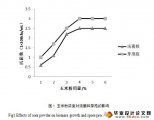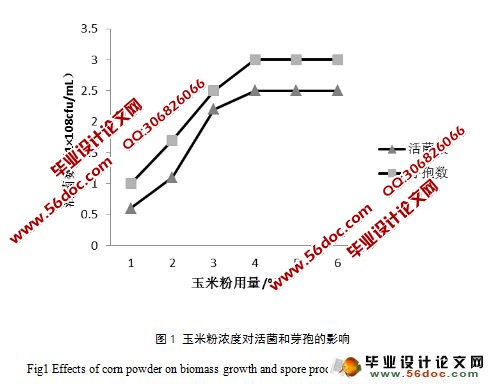丁酸梭状芽孢杆菌的高密度培养与研究
来源:56doc.com 资料编号:5D12124 资料等级:★★★★★ %E8%B5%84%E6%96%99%E7%BC%96%E5%8F%B7%EF%BC%9A5D12124

资料介绍
丁酸梭状芽孢杆菌的高密度培养与研究(毕业论文11000字) High Cell Density Cultural Conditions on Clostridium butyricum
Abstract: In order to increase the biomass growth and sporalution of Clostridium butyrium, the effects of the medium component and the fermentation conditions such as carbon sources, nitrogen sources, inorganic salt, cultural temperature, the initial pH value, cultural time were studied by single-factor test. The results showed that the optimal medium component were as follows: corn meal 4.0%, corn steep liquor 2.0%, CH3COONa·3H2O 0.03%, NaCl 0.2% K2HPO4 0.5%, MgSO4·7H2O 0.02%, MnSO4· H2O 0.02%,CaCO3 0.1%, the optimal fermentation conditions were, the initial pH 7.5, static culture 20h at 37℃, then continue to culture 16h at 30℃, the biomass growth and sporalution rate of Clostridium butyrium reached 8.4×108cfu/mL and 92.81%.
Key words:High Cell Density Culture; Optimize the condition of fermented; Clostridium butyricum
 目 录
摘要………………………………………………………………………………………….1
关键词……………………………………………………………………………………….1 1 前言……………………………………………………………………………………….2
1.1高密度培养的概念和意义………………………………………………………2
1.2酸菌的形态特征和生化特性……………………………………………………2
1.2.1形态特征………………………………………………………………….2
1.2.2生化特性………………………………………………………………….3
1.3丁酸菌的微生态学特性………………………………………………………..3
1.3.1微生态学效应…………………………………………………………….3
1.3.2药物敏感性……………………………………………………………….3
1.3.3抗逆性…………………………………………………………………….4
1.4丁酸菌的生物功能及应用………………………………………………………4
1.4.1丁酸菌对肠道菌群的作用……………………………………………….4
1.4.2促进生长功能…………………………………………………………….5
1.4.3免疫调节功能……………………………………………………………..5
1.4.4提供营养元素………………………………………………………………5
2 材料与方法………………………………………………………………………………6
2.1 实验材料…………………………………………………………………………6
2.1.1 菌种………………………………………………………………………6
2.1.2 主要仪器及试剂…………………………………………………………6
2.1.3 培养基……………………………………………………………………6
2.2 试验方法…………………………………………………………………………6
2.2.1 培养………………………………………………………………………6
2.2.2 高密度培养条件研究……………………………………………………6
2.2.3 检测方法…………………………………………………………………7
3 结果与讨论………………………………………………………………………………7
3.1 培养基配方的筛选…………………………………………………………….7
3.1.1 碳源种类及碳源浓度的筛选………………………………………….7
3.1.2 氮源种类及氮源浓度的筛选………………………………………….8
3.1.3 无机盐的浓度………………………………………………………….9
3.2 发酵条件的研究……………………………………………………………….10
3.2.1 发酵温度……………………………………………………………….10
3.2.2 初始pH值………………………………………………………………11
3.2.3 发酵时间……………………………………………………………….11
4 结论…………………………………………………………………………………….12
参考文献…………………………………………………………………………………..12
致谢…………………………………………………………………………………………14 |